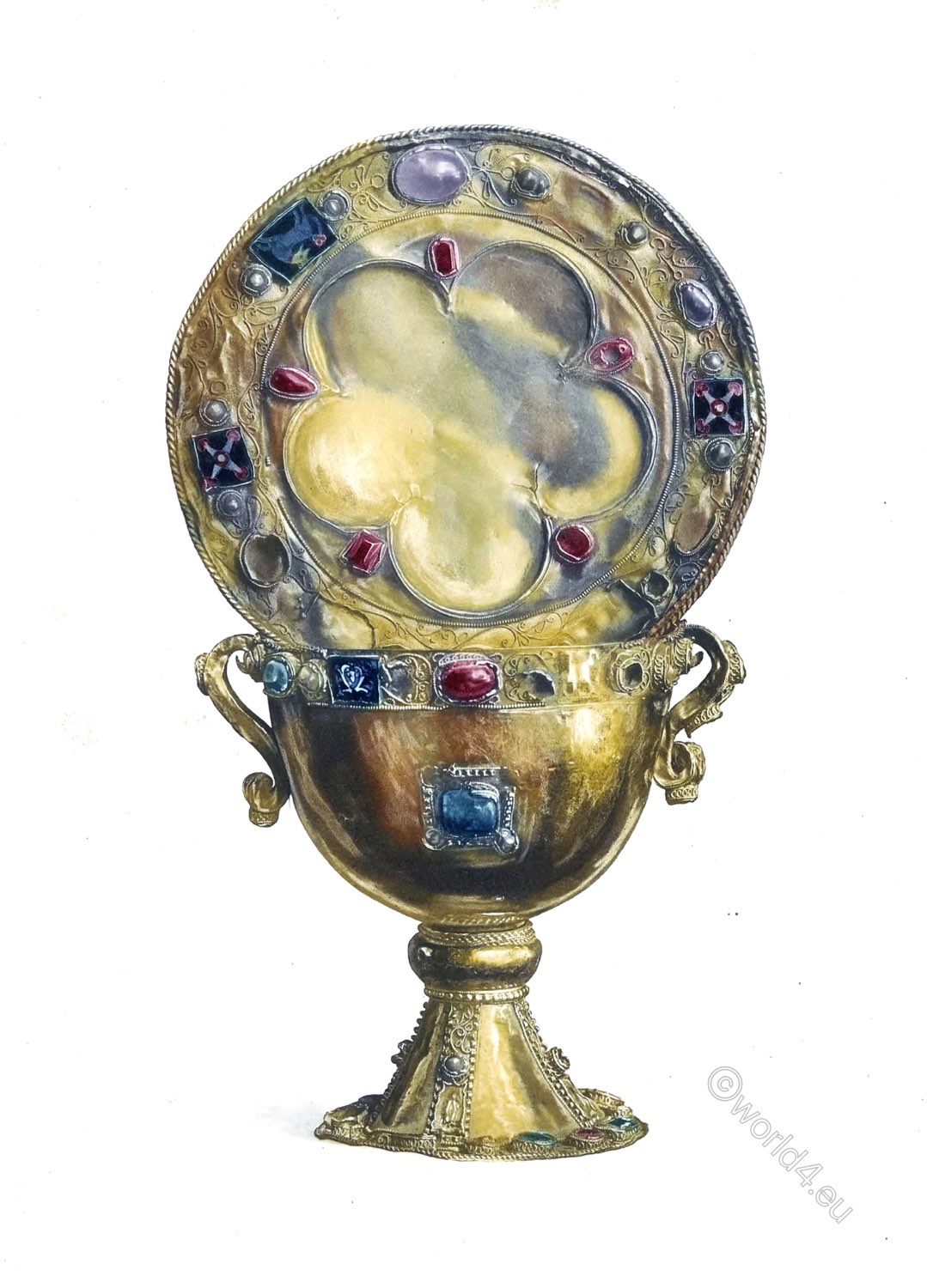
1 2 3 4 5 6 7
8 9 10 11 12 13 14
COSTUMES OF THE SPIRITUAL ORDERS. EUROPA. -10TH-18TH CENTURY
POLAND, GERMANY AND FLANDERS.
No. 1 and 11 – Monks of the Holy Sepulchre in Poland.
The Order of the Holy Sepulchre in Jerusalem was founded in Poland by Jaxa, a nobleman, in 1126 or 1162.
No. 1 wears the costume of the 17th and 18th centuries, No. 11 that of the earlier period.
No. 2 – Lay sister of the Order of the Servites (Germany).
The Order of the Servites was re-established in Germany by Katharina von Gonzaga, (1) the wife of Ferdinand of Austria. The sisters wore black, narrow tunics closed with a leather belt, white veils and breast cloths. In Germany there was a blue star on the front part of the veil falling over the forehead.
(1) Anna Caterina Gonzaga, Princess of Mantua and Montferrat, (27 January 1566 in Mantua; † 3 August 1621) Order name Anna Juliana.
No. 3 – Regulated Canon of the Lateran (Poland).
Father Helyot placed the foundation of this Fraternity, sometimes traced back to the Apostles, under the pontificate of Leo I. The Congregation was established under Bonifazius VIII. The friars wore over their skirts a shoulder coat reaching up to their knees, similar to that of the Roman prelates.
No. 4 – Monk of the Slavonic Order (Slavonic or Wendish, Order of Swordsbrothers, Order of Knights, part of the German Order State also called Livonian Order. The Livonian Order was an autonomous branch of the Teutonic Order founded in 1237. It was later a member of the Livonian League, from 1435 to 1561.). Wladislas V, King of Poland, founded this order in 1389 or 1390 with brothers brought from Prague. Red skirt with the same hood. Shorn skull, beardless.
No. 5 and 6 – Monks and nuns of the Magdalene Order (Latin: Ordo Sanctae Mariae Magdalenae de poenitentia. Order abbreviation: OSMM).
This order was founded in 1018 in Paris on the use of the Capuchin P. Athanasius Mole by his brother the general procurator Mole, the rich wine merchant Montry and an officer of the imperial bodyguard named du Fresne. The monasteries of the same were initially intended for the reception of fallen girls. Magdalene nuns or Magdelonetten (Sisters of the Order of St. Mary Magdalene to Penance, according to the Order of St. Augustine), also called the white ladies. The robe of the order was white for men and women. White robes, scapular cingulum and veil.
No. 7 – Monk of the Order of the Penitence of the Martyrs, founded in Poland in 1257 (Penitence lat. poenitere, paenitere “to feel repentance, to repent”).
Bolesław V. (1226-1279, also the Shameful Polish Bolesław V Wstydliwy), Duke of Krakow and Sandomir, was the founder. In the 17th century, house and choir skirts were white, formerly probably reddish grey. In 1257 a synod was held in Łęczyca in which it was stated that any ruler who would kidnap a bishop would automatically be excommunicated and his territories placed under ban. Between 11th and 12th June 1258 a meeting took place in Sandomierz where Bolesław V approved further privileges for the Lesser Poland Church. At the invitation of Bolesław V. and his wife Kinga, the Franciscans came to Krakow around 1258. In 1263 Bolesław V. founded a church in Krakow dedicated to the evangelist Mark (pl: Kościół św. Marka w Krakowie).
No. 8 – Penitent of the Lay Fraternity of Saint Francis in Flanders.
This order of penitents, founded in 1615 in Armentières by the cloth maker Henry Pringuel, Congregation of the 3rd Order of St. Francis. Long, brown skirt with wide sleeves, collar coat reaching up to the calves, as belt a rope, full beard, shaved skull, sturdy shoes, instead of the hood a hat. Teaching poor children, nursing.
No. 9, 10 and 14 – Monks of the Order of the Voluntarily Poor in Germany and Flanders.
The order is said to have been founded in 1370 in Hildesheim. After 1470 the costume of the order consisted of a grey skirt with black scapular and hood, above it, apart from the Hanseatic League, a long grey coat. In Flanders calf stockings without booties. In addition there was a basket for gifts and alms and a long staff ending in a crucifix.
No. 12 – Regulated Canon and Hospitaliter of the Order of the Holy Spirit in Poland.
The founder of the order was Guy of Montpellier at the end of the 12th century. The spiritual brothers carried a white cross on the cassock and cloak, similar to that of the knights.
No. 13 – Monk of the Order of the White Brothers (Prussia).
This order dates from the beginning of the 14th century to Schoonebeek, who mentions it alone, and received its name from the white coat decorated with a green Andreas wreath. Its members claimed to have special revelations about the reconquest of the Holy Land. Initially numerous, they soon perished in the general disbelief.
After the works of Father Helyot, Schoonebecks and Bars about the costumes of the spiritual orders.
Source: History of the costume in chronological development by Auguste Racinet. Edited by Adolf Rosenberg. Berlin 1888.
Related
Discover more from World4 Costume Culture History
Subscribe to get the latest posts sent to your email.






